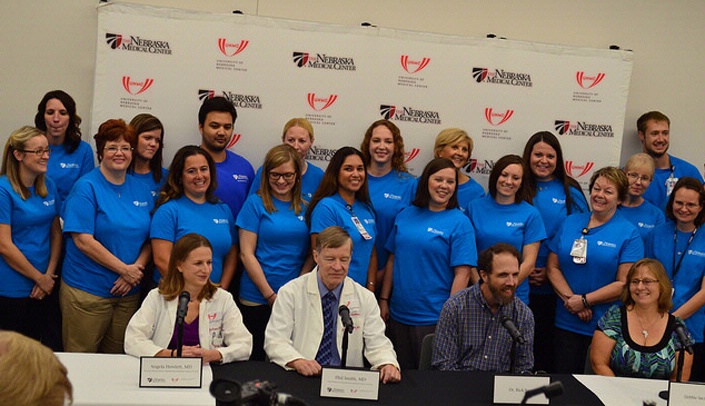A first-of-its-kind Ebola study yields clues to how some people are able to survive the deadly virus and suggests possible avenues for treatments that could save more lives.
Researchers at Centers for Disease Control and Prevention, Emory University School of Medicine, and the University of Nebraska Medical Center analyzed the immune responses of Ebola patients treated in the United States. Their study was recently published online in the Clinical Infectious Disease Journal in the article entitled, "Kinetic Analysis of Biomarkers in a Cohort of U.S. Patients with Ebola Virus Disease."
Three UNMC faculty members were co-authors of the article. They included: Chris Kratochvil, M.D., UNMC associate vice chancellor for clinical research, and vice president of research for Nebraska Medicine, UNMC’s clinical partner; Peter Iwen, Ph.D., director of the Nebraska Public Health Laboratory and professor of pathology and microbiology; and Philip Smith, M.D., professor of internal medicine, division of infectious diseases, and medical director of the Biocontainment Unit at Nebraska Medicine. Dr. Smith is retiring at the end of this month.
"These findings are encouraging and underscore how crucial it is to continue the fight against Ebola," said CDC Director Tom Frieden, M.D., M.P.H. "We must come up with new ways to keep people safe and combat diseases that threaten our health."
Ebola virus causes a severe and often fatal infection that can include fever, diarrhea and unexplained bleeding. Despite the fact that more than 30,000 individuals have acquired EVD since it was discovered in 1976, the medical and scientific community still does not have a clear understanding of the mechanisms by which Ebola causes such severe illness.
This is the first time researchers have been able to study Ebola virus disease (EVD) using samples taken from patients during both their illness and recovery. In the seven U.S. patients, researchers tracked 54 different markers of immune-system activity from hospital admission until the day of discharge. Among the seven patients, five had moderate EVD and two had severe EVD requiring mechanical ventilation and dialysis.
"We were able to identify the particular components of patients’ immune systems that successfully fought off the virus," said lead author Anita McElroy, M.D., Ph.D., who is a guest researcher in CDC’s Viral Special Pathogens Branch and an Emory physician and faculty member. "These are the parts of the immune system that we need to tap into to develop new therapies."
The results show patients with severe EVD had high levels of virus in their blood and out-of-control immune responses leading to destruction of healthy tissues, multisystem organ failure, shock, and, in most cases, death. In contrast, patients with moderate EVD had strong, healthy immune responses that were able to control the virus. All of the patients with moderate illness and one patient with severe illness survived.
It is unclear why exactly some people’s immune systems respond more effectively to viruses. Possible contributing factors include genetics and whether or not a person has other illnesses or conditions. Identifying which parts of the immune system malfunction in severe EVD cases as well as the parts that function well in the moderate cases could lead to the design of therapies that might theoretically inhibit the disease’s progression.
Here is a copy of the article and a summary of the article.
U.S. Department of Health and Human Services
CDC works 24/7 protecting America’s health, safety and security. Whether diseases start at home or abroad, are curable or preventable, chronic or acute, stem from human error or deliberate attack, CDC is committed to respond to America’s most pressing health challenges.
